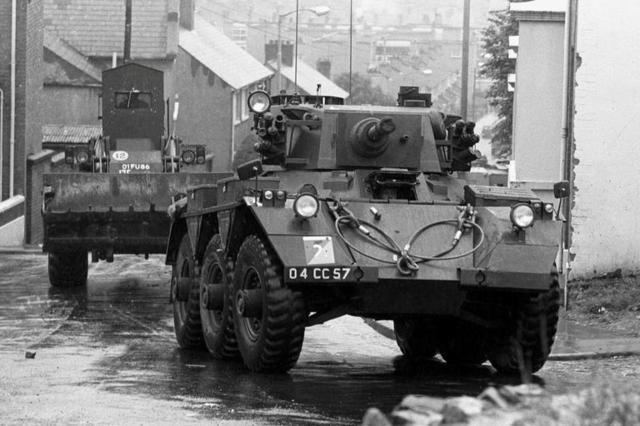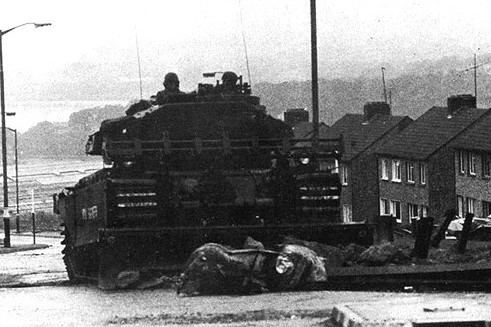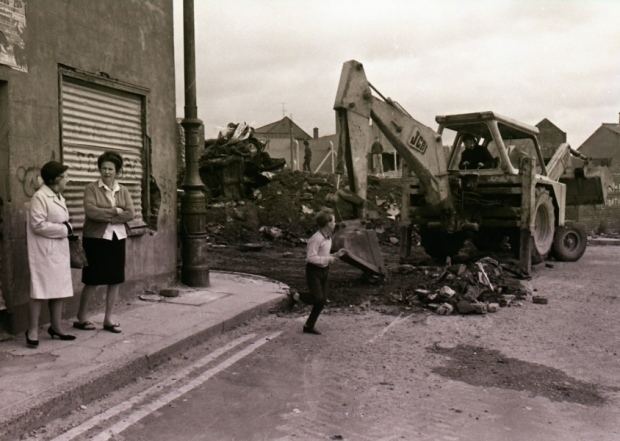Outcome Operation succeeds Result Operation succeeds | Date 31 July 1972 | |
 | ||
Location BelfastDerryNewryArmaghLurganCoalisland Casualties Civilians: 1 killed, 2 woundedProvisional IRA: 1 killed Similar The Troubles, Operation Demetrius, Falls Curfew, Operation Flavius, Battle of the Bogside | ||
Insight operation motorman 1972
Operation Motorman was a large operation carried out by the British Army (HQ Northern Ireland) in Northern Ireland during the Troubles. The operation took place in the early hours of 31 July 1972 with the aim of retaking the "no-go areas" (areas controlled by residents, usually Irish republican paramilitaries) that had been established in Belfast, Derry and other large towns.
Contents

Background

The Northern Ireland riots of August 1969 marked the beginning of the conflict known as "the Troubles". As a result of the riots, Northern Ireland's two main cities, Belfast and Derry, had become more segregated than before. Many neighbourhoods became entirely Irish nationalist or entirely unionist. In some places, residents and paramilitaries built barricades to seal off and protect their neighbourhoods from incursions by "the other side", the security forces or both. These became known as "no-go areas".
By the end of 1971, 29 barricades were in place to block access to what was known as Free Derry; 16 of them impassable even to the British Army's one-ton armoured vehicles. Many of the nationalist no-go areas were controlled by one of the two factions of the Irish Republican Army, the Provisional IRA and Official IRA. On 29 May 1972, the Official IRA called a ceasefire and vowed that it would not launch attacks except in self-defence.
On 21 July 1972, in the space of 75 min, the Provisional IRA detonated 22 bombs in Belfast. Eleven people (including two soldiers and a loyalist volunteer) were killed and 130 were injured. The attack prompted the British Government to implement Operation Motorman, just ten days later.
Preparations
Operation Motorman was the biggest British military operation since the Suez Crisis of 1956 and the biggest in Ireland since the Irish War of Independence. In the days before 31 July, about 4,000 extra troops were brought into Northern Ireland. Almost 22,000 soldiers were involved, including 27 infantry and two armoured battalions, aided by 5,300 soldiers from the local Ulster Defence Regiment (UDR). Several Centurion AVRE demolition vehicles, derived from the Centurion tank and fitted with bulldozer blades, were used. They were the only heavy armoured vehicles to be deployed operationally by the British Army in Northern Ireland during the Troubles. The tanks had been transported to Northern Ireland on board the amphibious landing ship HMS Fearless, and were operated with their turrets traversed to the rear and main guns covered by tarpaulins.
This quick military buildup alerted the Provisional IRA and Official IRA that a major operation was being planned. According to local MP Ivan Cooper and others, the IRA left Derry's no-go areas the day before the operation.
Operation
The operation began at about 4:00 AM on 31 July and lasted for a few hours. In "no-go areas" such as Free Derry, sirens were sounded by residents to alert others of the incursion. The British Army used bulldozers and Centurion AVREs to break through the barricades before flooding the no-go areas with troops in smaller, lighter armoured vehicles. The Provisional IRA and Official IRA were not equipped for open battle against such a large force and did not attempt to hold their ground. Small scale operations were carried out in other places like Lurgan, Armagh, Coalisland and Newry.
By the end of the day, Derry and Belfast had been cleared of no-go areas, but the Army remained cautious when operating in staunchly republican districts.
Casualties
During the operation, the British Army shot four people in Derry, killing a civilian and an unarmed IRA member.
In Belfast, some arrests were made but no armed resistance was met.
Aftermath
A few hours after the conclusion of Operation Motorman, the Claudy bombing occurred. Nine civilians were killed when three car bombs exploded on the Main Street of Claudy village, County Londonderry. Five of the victims were Catholic and four were Protestant.
